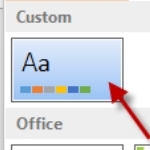
By Ellen Finkelstein
Using the 3rd dimension on a slide
In this post, I explain in detail how to use 3D rotation. I start with PowerPoint 2007 and PowerPoint 2010; then I explain where to find similar features in PowerPoint 2003.
In Part I of this series, on shadows, I showed you how to use shadows for both subtle and dramatic 3D effects.
The second 3D technique I want to cover is bevels, but I’ve already done that in my post, “Create professional-looking 3D effects with bevels.”
Bevels often work hand-in-hand with 3D rotation, especially when you specify a depth in the 3-D Format section of the Format Shape dialog box. That’s because you can’t see the depth until you rotate the object. These 2 objects are the same, but only the right one shows the depth, because you’re looking at it from an angle. That’s what 3D rotation does–it shows you an object from an angle.
Many people are unaware of the 3D features of PowerPoint, but they’ve been around for a long time. Even PowerPoint 2003 lets you rotate objects in 3D, although the controls are not as precise.
Use 3D rotation in PowerPoint 2007 and PowerPoint 2010
To create a shape with depth and rotate it, follow these steps in PowerPoint:
This excerpt is shared with permission from ellenfinkelstein.com.




